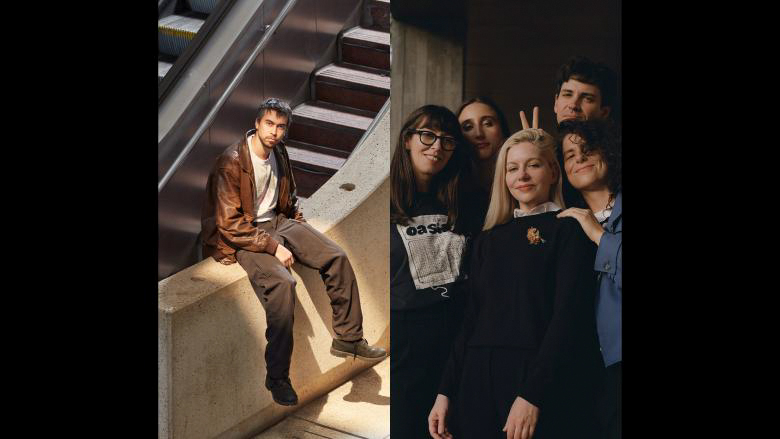Event Info
WED, AUG. 23
Doors 6:00 PM / Show 7:00 PM
**This is a ticketed Benefit Show that supports BRIC’s free programming. See here for our full season lineup.**
**Please note that you are NOT allowed to bring your own seating to this show.**
![]()
**Please note that all tickets are General Admission, including Platinum Tickets (which are regular tickets that are dynamically priced up and down based on demand – they are not part of VIP packages). Event is rain or shine. **
About Alex G:
God Save the Animals opens with a sort of credo: “After all,” sings Alex Giannascoli, the 29 year-old, Philadelphia-based musician best known as Alex G. “People come and people go away / Yeah, but God with me he stayed.” The first two words (which also comprise the song’s title) suggest the inevitability of change and the artist’s passive, if conflicted, relationship to it. Similar sentiments have appeared across Giannascoli’s oeuvre, but here, on his fourth full-length for Domino and ninth overall, he seems drawn to a particular outlet for feelings of helplessness: “God” figures in the LP’s title, its first song, and multiple of its thirteen tracks thereafter, not as a concrete religious entity but as a sign for a generalized sense of faith (in something, anything) that fortifies Giannascoli, or the characters he voices, amid the songs’ often fraught situations.
The people in Giannascoli’s songs place faith elsewhere as well, namely in those around them. “You can believe in me,” sings the narrator of “Cross the Sea,” his voice pitched-down, husky. Characteristic in not just its lyrical stance but also its layered production, “Cross the Sea” was the first song Giannascoli wrote for God Save the Animals, starting it in late 2019, after the first tour for his prior album, House of Sugar. The track builds from a quiet pairing of acoustic guitar and autotuned vocals, and subtly introduces new elements — the narrator’s intonation, a complex drum beat, new voices weaving in and out — before dissolving into a haze of synthesizer and piano. Giannascoli credits his approach, in part, to the internalized influence of pop radio, the tendency of current hit songs to cloak the artist’s voice in a range of modifications and levels of fidelity.
He wonders, too, if radio-listening habits encouraged him to labor carefully over the sound of God Save the Animals, seeking straightforwardly high-end mixes. As with records since his adolescence, Giannascoli wrote and demoed these songs by himself, at home; but, for the sake of both new tones and “a routine that was outside of my apartment” during the pandemic, he began visiting multiple studios in greater Philadelphia. God Save the Animals consequently features the work of some half-dozen engineers whom Giannascoli asked to help him produce the “best” recording quality, whatever that meant. The result is an album more dynamic than ever in its sonic palette, its thoroughgoing complexity, where tracks like the eerie and unpredictable rock song “Ain’t It Easy” follow logically from “No Bitterness,” which itself transitions midway from a skittering but contemplative ballad to something like hyperpop.
Beyond the ambient inspiration of pop, Giannascoli has been drawn in recent years to musicians like Gillian Welch and writers like Joy Williams, artists who balance the public and hermetic, the oblique and the intimate, and who present faith more as a shared social language than religious doctrine. Giannascoli achieves such balance in both text and sound, deploying quotation and varied vocal textures that present the given scenarios as immediate and distant at the same time. The songs “feel confessional to me,” he says, but “they’re not necessarily all true. I convince myself of things.” Filtering his experiences through fact and fiction, and through narrators with varying degrees of reliability, Giannascoli also opened up the songs through a more practical method: collaboration. God Save the Animals features several individual contributions from his bandmates (guitarist Samuel Acchione, drummer Tom Kelly, and bassist John Heywood) or frequent collaborator Molly Germer on strings and/or vocals, whose presences loosen up songs like “Mission” and “Early Morning Waiting.”
“Blessing” showcases the full band playing together live, a tactic Giannascoli last employed on House of Sugar’s “SugarHouse.” “Blessing” picks up on the synthesized noise that concludes its predecessor, “Cross the Sea,” but soon gives way to a muscular drumbeat. What follows is a study in contrasts: The lyrics trade in flashes of hope (“Every day / Is a blessing”) and vague but tense images (“If I live / Like the fishes / I will rise / From the flood”); the music remains sedate but hints at heavy rock bombast; and, while the vocals mostly proceed in whispered call-andresponse, an occasional firm grunting noise cuts through the mix. The whispers — featured across God Save the Animals — were inspired by listening back to quiet, late-night voice memos, while the tone and composition, here, draw obliquely from rock staples of Giannascoli’s youth, such as Audioslave’s “Like a Stone.” An indirect but nostalgic invocation, the link suits
Giannascoli’s larger songwriting project. He has long mined both his own and a shared past, that is, even if he doesn’t quite know why he does it. “It’s almost like I’m replaying situations that felt impactful to me,” he offers, “and like I’m rewriting them a million different ways.”
One might say, then, that God Save the Animals presents its narrators as “Naked in my innocence / Tangled in my innocence,” to repurpose the opening lines “S.D.O.S.” They dwell on the past, revisiting its agonies and ecstasies, but also look to the future (“we should have a baby,” someone says in “Miracles”). They feel resignation and guilt (“Forgive”); they act impulsively and say things they might not mean or understand (“Immunity”). Structurally organic and sonically meticulous, the music here heightens the drama of their stories in some cases and their playfulness in others. The album cover, painted, as always, by Giannascoli’s sister, Rachel, likewise both estranges and entices in its depiction of a species of titular animal. To that end, someone asked Giannascoli if the breezy rock tune “Runner” was about a dog: “My runner, my man.” Maybe it is. Or, maybe it’s something else. It remains unclear who — or what — gets up to the “bad things” that the song invokes, or what constitutes “bad things” in general. It’s a common theme for Giannascoli, the bad and the good, the right and the wrong, but he and his characters seem provocatively, reasonably unsure sometimes of which is which. God save the animals, at least.
About Alvvays:
Alvvays never intended to take five years to finish their third album, the nervy joyride that is the compulsively lovable Blue Rev. In fact, the band began writing and cutting its first bits soon after releasing 2017’s Antisocialites, that stunning sophomore record that confirmed the Toronto quintet’s status atop a new generation of winning and whip-smart indie rock.
Global lockdowns notwithstanding, circumstances both ordinary and entirely unpredictable stunted those sessions. Alvvays toured more than expected, a surefire interruption for a band that doesn’t write on the road. A watchful thief then broke into singer Molly Rankin’s apartment and swiped a recorder full of demos, one day before a basement flood nearly ruined all the band’s gear. They subsequently lost a rhythm section and, due to border closures, couldn’t rehearse for months with their masterful new one, drummer Sheridan Riley and bassist Abbey Blackwell.
At least the five-year wait was worthwhile: Blue Rev doesn’t simply reassert what’s always been great about Alvvays but instead reimagines it. They have, in part and sum, never been better. There are 14 songs on Blue Rev, making it not only the longest Alvvays album but also the most harmonically rich and lyrically provocative.
There are newly aggressive moments here—the gleeful and snarling guitar solo at the heart of opener “Pharmacist,” or the explosive cacophony near the middle of “Many Mirrors.” And there are some purely beautiful spans, too—the church- organ fantasia of “Fourth Figure,” or the blue-skies bridge of “Belinda Says.” But the power and magic of Blue Rev stems from Alvvays’ ability to bridge ostensible binaries, to fuse elements that seem antithetical in single songs—cynicism and empathy, anger and play, clatter and melody, the soft and the steely. The luminous poser kiss-off of “Velveteen,” the lovelorn confusion of “Tile by Tile,” the panicked but somehow reassuring rush of “After the Earthquake”. The songs of Blue Rev thrive on immediacy and intricacy, so good on first listen that the subsequent spins where you hear all the details are an inevitability.
This perfectly dovetailed sound stems from an unorthodox—and, for Alvvays, wholly surprising—recording process, unlike anything they’ve ever done. Alvvays are fans of fastidious demos, making maps of new tunes so complete they might as well have topographical contour lines.
But in October 2021, when they arrived at a Los Angeles studio with fellow Canadian Shawn Everett, he urged them to forget the careful planning they’d done and just play the stuff, straight to tape. On the second day, they ripped through Blue Rev front-to-back twice, pausing only 15 seconds between songs and only 30 minutes between full album takes. And then, as Everett has done on recent albums by The War on Drugs and Kacey Musgraves, he spent an obsessive amount of time alongside Alvvays filling in the cracks, roughing up the surfaces, and mixing the results. This hybridized approach allowed the band to harness each song’s absolute core, then grace it with texture and depth. Notice the way, for instance, that “Tom Verlaine” bursts into a jittery jangle; then marvel at the drums and drum machines ricocheting off one another, the harmonies that crisscross, and the stacks of guitar that rise between riff and hiss, subtle but essential layers that reveal themselves in time.
Every element of Alvvays leveled up in the long interim between albums: Riley is a classic dynamo of a drummer, with the power of a rock deity and the finesse of a jazz pedigree. Their roommate, in-demand bassist Blackwell, finds the center of a song and entrenches it. Keyboardist Kerri MacLellan joined Rankin and guitarist Alec O’Hanley to write more this time, reinforcing the band’s collective quest to break patterns heard on their first two albums.
The results are beyond question: Blue Rev has more twists and surprises than Alvvays’ cumulative past, and the band seems to revel in these taken chances. This record is fun and often funny, from the hilarious reply-guy bash of “Very Online Guy” to the parodic grind of “Pomeranian Spinster.” Alvvays’ self-titled debut, released when much of the band was still in its early 20s, offered speculation about a distant future—marriage, professionalism, interplanetary citizenship. Antisocialites wrestled with the woes of the now, especially the anxieties of inching toward adulthood. Named for the sugary alcoholic beverage Rankin and MacLellan used to drink as teens on rural Cape Breton, Blue Rev looks both back at that country past and forward at an uncertain world, reckoning with what we lose whenever we make a choice about what we want to become.
The spinster with her Pomeranians or Belinda with her babies? The kid fleeing Bristol by train or the loyalist stunned to see old friends return? “How do I gauge whether this is stasis or change?” Rankin sings during the first verse of the plangent and infectious “Easy on Your Own?” In that moment, she pulls the ties tight between past, present, and future to ask hard questions about who we’re going to become, and how. Sure, it arrives a few years later than expected, but the answer for Alvvays is actually simple: They’ve changed gradually, growing on Blue Rev into one of their generation’s most complete and riveting rock bands.
About Tanukichan:
Tanukichan is the solo project of classically-trained Bay Area native Hannah van Loon, whose music screeched to a halt when she discovered what she affectionately calls “dad rock” in her tween years. Throughout her self-described “sheltered” adolescence, van Loon taught herself guitar by spending hours in front of the radio, replicating riffs and chords from omnipresent bands like The Beatles and Incubus.
The Lena Horne Bandshell at Prospect Park is home to BRIC Celebrate Brooklyn!, New York’s longest-running, free outdoor performing arts festival. Named to honor the legendary singer, actress, dancer, and Brooklyn native Lena Horne, the Bandshell is transformed into a venue every summer that can accommodate over 8,000 people.
Accessibility
The facility is completely wheelchair accessible. Accessible entrances, exit points, seating, and concessions are available for every event. When you arrive at the Bandshell, you are welcome to ask any of our entrance staff for assistance. Our Community Care Manager and team will escort you and one guest to an accessible seat. Please note that our ADA seating section is first-come first-serve and some views of our stage may be partially obstructed. If you have any other questions about accessibility, please contact [email protected].
About BRIC Celebrate Brooklyn!
This event is part of BRIC Celebrate Brooklyn!, New York City’s longest-running, free, outdoor performing arts festival, held every summer at the Lena Horne Bandshell in Prospect Park.



